Te reo classroom phrases, printables by the dozens and fun Māori games, activities and resources are all available in this bundle. This will help with your planning for next year.

I’m super excited to offer this te reo Māori teaching resource bundle based around our Level one curriculum guidelines-
Te Aho Arataki Marau mō te Ako i Te Reo Māori – Kura Auraki which can be viewed online.
It is part of our New Zealand Code of Professional Responsibility and Standards for the Teaching Profession, that all teachers practise and develop the use of te reo and tikanga Māori.
Most importantly- at this time all of my products have a full school licence. This means that your whole school can use this resource.
Greetings, Farewells and Acknowledgements in Te Reo Māori
Achievement Objectives 1.1 and 1.6
*1.6 Understand and use simple polite conventions, for example, ways of acknowledging people, expressing regret and complimenting people
.
Hello to one
Hello to two
Hello to three or more
Goodbye to those staying
Goodbye
See you at another time
Thanks so much
These are stunning enlarged and look beautiful accompanying these resources.
Introducing yourself in te reo Māori
We have used the neutral form of “taku” (my) in this resource. This aligns with “He Reo Tupu, He Reo Ora” teaching resource put out by the Ministry of Education.
Learning Intentions:
• recognise, understand, and use familiar words about ourselves and our whānau
• recognise, understand, and use short phrases about ourselves and our whānau
• ask and answer simple questions about another person’s whānau
• use ordinal numbers to tell my or someone else’s place in the whānau
• ask and answer a question about my or someone else’s age
There are plenty of activities and support materials in this pack. The variety means that you can use it at different levels of the school.
Kupu o te rā has some other words to support you if you want the names for other members of your whānau.
Learning the date in te reo Māori
*Communicate about numbers, using days of the week, months and dates
This te reo Māori Maramataka (calendar) resource will be so helpful. For the whole school, all learners can benefit in some way. Includes:
*both sets of Days of the Week with posters explaining the meanings behind the Māori Language Commission names
(Did you know Rāhina was named after Māhina the moon?).
Here on “Kupu o te rā” you hear soundbites for these days if you need help with pronunciation.
*Ordinal numbers-How to say the 1st, 2nd etc.
*How to give the full date
*How to ask “When is your birthday?”
*Fantastic mini book with all these facts as a reference. Older learners can make activities (word search, games puzzles etc) to teach others.
Maramataka is black and white so you can colour code the days, months and numbers to suit.
BRIGHT POSTERS. Packed with so much learning at any level!!

How to Write a Pepeha
Writing a pepeha can be a little confusing for learners. This te reo Maori resource has visuals and explanations to help with the understanding of a pepeha.
Bright and engaging, this should make the process easier.
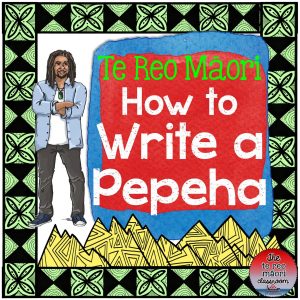
Locations in te reo Māori
*Communicate about location
This te reo resource was made to help teachers and learners simplify understanding “locations” or prepositions (Tūwāhi).
It incorporates speaking, reading, writing and fun activities.
Teachers’ instructions are in English and worksheets are in either te reo only or English.
Resource includes:
*Location posters (which can be made into a book)
*Word picture matching activities (In black and white-print on coloured paper)
*Self-correcting sentence making activity (In black and white-print on coloured paper)
*Writing correct location words under picture (Tuhia te kupu tika o ēnei ki te wāhi e tika ana.)
*A foldable first reader book which can be taken home to share with whānau! This is so helpful to progress reading.
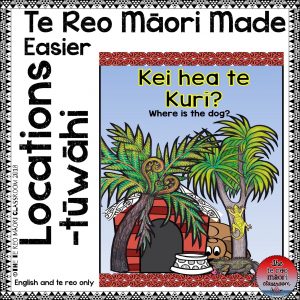
Te Reo Classroom Timetable
Karakia, roll call, values, karakia for kai, news, morning tea, lunch, brain food, snack, brain break, maths/numeracy, reading, silent reading, science, sport, run, fitness, swimming, Library, spelling, handwriting, Inquiry, topic, waiata, assembly, hui, mindfulness, art, mat time, writing, literacy, digital fluency, social studies, finishing off work, computer time, health, te reo, poetry, choosing time, music, golden time, play time, group discussion, workshop, buddy time, oral language, whānau time, R.E, kapa haka, creative writing, silent reading, tidy up time, homework, discovery time, special event, Finished home time, see you tomorrow, see you next week, wash your hands….
Te Reo Classroom Phrases For Teachers
Are you looking for an easy way to integrate more te reo Māori in your classroom?
This resource has 60 plus phrases (rerenga kupu) and words (kupu) to help you with more te reo on a daily basis.
The format is the same as the Te Reo Classroom Timetable so it fits in well if you are a selective decor person!
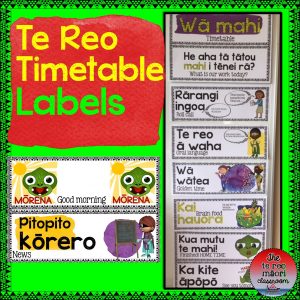

Rerenga kupu/kupu include;
Learn/teach
Learners
Stand up
Sit down
Yes
No
Be brave/ hang in there
Great
Very good
Excellent
Drink!
Eat!
Friend
You can do it!
Have a good day
I had a good day
I’m sorry
Tidy the room!
QUIET!
Line up here
Line up over there
Let’s go
Work hard
Open the door
Shut the door
Hat
Take off your hat
Put on your hat
Where is your hat? (popular!!!)
Shoe
Take off your shoes
Do you understand?
Questions?
Can you help me please?
Finished?
Smile!
Relax
Don’t talk
Here
Lets begin the karakia
Lets begin the song
What’s wrong?
What’s the Māori word for…?
Who will start?
Think carefully
Be careful
Go to the playground
My bad!
Come here
Go away
Give me
Give to
What’s this?
What are these?
Look at me
Look away (over there)
Listen to me
Talk to me
Wait
Don’t forget
Follow me
Are you ready?
I know these will be really valuable if you are just starting your te reo journey beside your ākonga.
In addition to these phrases/words there are other replies and words to be learned from the labels.
You can read about Classroom phrases and adding more te reo to your classroom walls in another blog.
Feelings in Te Reo Māori
Do you want to take your learners from asking “How are you?” to “How is she/he?”
Do you want to include kīwaha and every day conversational reo in your programme?
If so, this rauemi is for you and your learners! The expressive characters will help with the identifying and understanding of the feelings/emotions kupu.
angry
brave
cold
confused
curious
disappointed
embarrassed
excited
fed up/frustrated
good
grumpy
happy
healthy
hot
hungry
lonely
nervous
proud
sad
scared
sick
silly
stressed
surprised
thirsty
tired
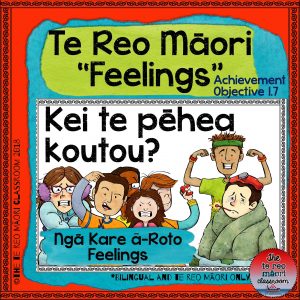
*27 “feelings”
*1 set bilingual (te reo Māori/English)
*1 set te reo Māori only
*E pēhea ana koe? and Kei te pēhea koe?
*6 kīwaha (colloquial sayings- call outs)
*Mini book-Ākonga make and read, this promotes reading and is a great take home activity to share with whānau.
(This is the same resource which is sold separately “Kei te Pēhea Koe.” Mini book)
Listen to Mr Five year old reading his mini book.
Whakataukī About Active Learning

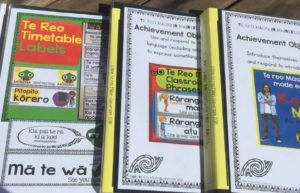
They can be kept on the server and/or in folders for the hardcopy people.
This fabulous Teaching Te Reo in Mainstream Schools Level 1 Bundle is available H E R E.

